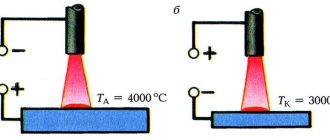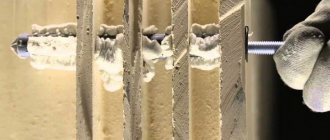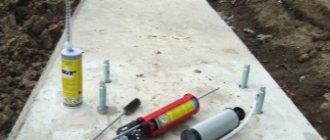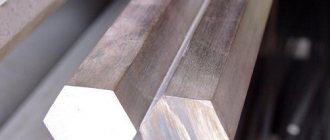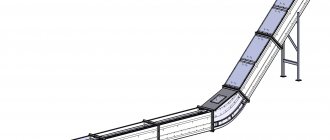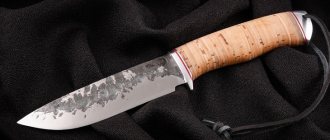Useful information about the practical use of a wedge anchor - one of the most reliable hardware for fixing heavy objects on concrete surfaces.
The wedge anchor for concrete has the best holding capacity among mechanical type expansion fasteners, which allows it to be used for heavy and medium loads. It consists of a threaded stud at one end and a spacer at the other. The fastener comes with a nut and washer. When the nut is tightened, the tapered shank is pulled into the collet sleeve, wedging it apart and thereby ensuring rigid fixation in the hole.
Design
The wedge anchor consists of two parts:
- Rods (pins) with a flat round cap (head).
- The spacer element is a wedge (see photo).
The body of the main rod is cylindrical; along its entire length it has a flat (groove), the depth of which at the rear end decreases to zero. In the cap, eccentrically towards the center, there is a segment-shaped hole into which a spacer element is inserted, representing the same segment in cross-section. The thickness of this element disappears at the rear end. In the initial state (sales presentation), the front end of the wedge protrudes above the plane of the head by 10 mm. In this position it is secured by a special stamping bend of the wedge itself.
The product of standard size 6/40 has the following geometric proportions: the diameter of the cap is 10 mm, its thickness is 2.5 mm. The width of the spacer element above the cap is 5.5 mm, thickness is 2.5 mm. The total length of the rod with the cap is 39 mm, the spacer wedge is 43 mm. The diameter of the main rod at the rear end (where the flat disappears) is 5.8 mm. This dimension is critical and has a tolerance of only ±0.05mm.
When assembled, the wedge anchor is a round rod with a diameter of no more than 6 mm, limited on one side by a lock washer with the end of the spacer rod protruding from its plane.
In the production of wedge anchors in Russia, carbon steels St2kp, St2sp, St2ps are used, in China - Q215, in Europe - DIN EN 10263-4-2002. To protect against corrosion, a 5-micron thick zinc coating (white or yellow-passivated) is used.
How does a wedge anchor work?
The principle of operation of the wedge anchor is not difficult to understand - it holds parts attached to the ceiling or wall by the force of friction between the walls of the hole and the body of the wedge fastener.
Holes with a diameter of 6 mm are drilled in the part to be fixed and in the wall, into which a wedge anchor is inserted through the part. Pressing the cap against the wall, hammer in the spacer element until its outer end is completely immersed in the cap. In this case, the wedge with its rear end runs into the groove ramp and, with great friction, pushes this part into the wall.
At this point, the diameter of the assembly increases to 6-7 mm (depending on the hardness of the base), and it is firmly wedged, holding the part. It is impossible to get the wedge anchor back. To release the attached part, you can cut off (grind off) the head of the anchor wedge with the disk of an angle grinder.
Markings and design features
The wedge anchor consists of the following elements:
- stud with external metric thread, made of metal;
- cylindrical movable coupling in the form of a belt;
- tapered shank;
- nut for reliable fixation of the structure.
The choice of anchor depends on the operating conditions, as well as the weight of the object being secured, the thickness of the fastening part and other parameters. Special markings are provided for convenience. The wedge anchor is abbreviated as WAM. This value is followed by numbers that indicate the diameter, length and type of thread of the structure.
Scope of application: what is the wedge anchor used for?
The most widespread use of the wedge anchor is noted in various fields of construction, electrical installation, ventilation and pipe wiring. Using this type of fastener, the following is mounted on the ceiling and walls:
- dropped ceilings;
- ventilation ducts and grilles;
- perforated strips for fastening window and door frames;
- cable route sites;
- steel profiles for partitions, plasterboard sheathing;
- metal corners, channels, strips;
- fire-fighting devices, garlands of lighting systems.
The number of attachment points for the described elements in new construction or large-scale reconstruction is thousands of units. A significant reduction in the labor intensity of these works is the most profitable option for increasing productivity and reducing the cost of work.
The wedge anchor is intended for use exclusively in solid wall and ceiling materials - concrete, brick and dense natural stone. It cannot be used in soft materials - shell rock, gypsum, aerated concrete, foam concrete, wood concrete or plaster.
Various guides on how to use a wedge anchor are most often aimed at performing ceiling work. Because their hands are constantly raised, they are considered one of the most complex and highest paid manual operations. Therefore, reducing the labor intensity of this type of work is very productive for both customers and performers.
In general, working with a wedge anchor is easier than working with a nut, bolt, or frame anchor, since the operation of tightening nuts or bolts is eliminated. Simply insert the fastener into the hole and secure it permanently in the wall or ceiling .
Varieties
The strength and reliability of such fastening, moreover, combined with the speed of installation and relatively low cost, force manufacturers to seek new modifications of the wedge anchor. In addition, fasteners of this type are very popular in everyday life precisely because of their ease of installation, so in some cases new options are designed not so much for fastening strength as for convenience.
According to the material of manufacture
Based on the material used, wedge-type anchors are divided into 3 groups:
- made of structural steel - fasteners must be galvanized in order to ensure corrosion resistance of the material;
- Stainless steel models do not need galvanizing and have the same strength. However, due to the high cost, they are usually produced only to order. An anchor of this type can be used for chemical anchoring;
- models made of special alloys, including non-ferrous metals. Their characteristics are determined by the composition of the alloy.
Wedge anchor Rawlplug 16/30-150
By design differences
Based on structural differences, the following types are distinguished:
- with a washer – a wide washer ensures tight contact between the element being fixed and the surface. Typically used in cases where the object being secured is made of light, loose material;
- with a nut – a wedge anchor, the basic version, where the nut holds the element being fixed, and the spacer ensures fixation to the wall;
- with a ring - or with a hook. The design feature is designed for hanging objects: cable, rope, chandelier, water heater. The model with a hook allows you to remove the item if necessary;
- with impact spacer – fasteners for through installation. The difference is that here the wedging of the sleeve occurs not when the nut is tightened, but when the nail is driven into the anchor, through the material being fastened;
- ceiling - has an unusual design. Instead of a conical shank, there is a wedge-shaped spacer, the length of which is only slightly less than the body of the anchor. This model allows you to mount heavy volumetric chandeliers on the ceiling.
By additional properties
Manufacturers quite often offer new modifications, which are essentially variants of existing ones, but with some additional properties.
- For example, Mungo's anchor bolt, thanks to its four-leaf sleeve, is highly resistant to twisting.
- The FAZ anchor bolt from Fischer features a special profile and sleeve design that increases tensile strength by 38%. The bushing ensures a more uniform load distribution and has the ability to expand. Such fasteners can be used in tensile concrete.
- Double-spacer anchor - has 2 cylindrical spacer sleeves. When tightening the nut, two bushings are wedged out at once, which ensures a very strong fastening. This is an option for fixing in solid materials - stone, concrete, or similar heavy massive structures. For cellular concrete or limestone - any material that tends to crumble, fasteners cannot be used.
Simple installation of wedge anchors is shown in this video:
How to choose the right wedge type anchor?
When selecting an anchor wedge and where to use it, you must be guided by the following requirements:
- The drilling depth must be at least 5 mm greater than the length of the anchor wedge.
- The maximum thickness of the attached part should be 5 mm for a 6/40 wedge anchor and 8 mm for a 6/60 fastener.
- The minimum axial tearing force for a 6/40 wedge anchor in B25 concrete is 367 kg of mass, for a 6/60 wedge - 510 kg. These data must be consistent with the values of the permissible loads.
Installation
The installation of the fasteners itself is very simple. Much more attention has to be paid to the selection of products. In this case, it is necessary to take into account a variety of types of load:
- dynamic – percussion, impulsive, harmonic;
- static - that is, constantly acting: the weight of the connection, the weight of the structure being fixed, the action of wind, snow, rain.
Reinforced wedge anchor M8x65
Calculations
When calculating, it is necessary to take into account both fastener indicators and surface material. Product characteristics are given in reference materials.
- The pull-out load depends not so much on the fasteners as on the base material. When selecting, it is considered normal if the working load for pulling out is 25% of the maximum. So, if the base is concrete or solid brick, the working load for pulling out will be 350 kg, and if it is cellular concrete, then no more than 230 kg.
- Load-bearing capacity is determined by the design and material of manufacture. Products made of stainless steel have the highest indicators, brass models have the lowest.
- Shear - or bending - load is especially important for large dynamic loads. As the length and diameter of the anchor increases, the permissible load also increases. It is taken into account that under such influences the anchor acts like a lever.
The parameters and quantity of fasteners are determined by a combination of all of the above factors.
Installation
Installation using a wedge anchor is simple, but requires precision and care, since it is no longer possible to dismantle it.
- The place of fastening is determined - it should be the body of the brick or concrete, but in no case the gap between the bricks filled with cement mortar.
- A hole is drilled in the surface with a diameter exactly corresponding to the diameter of the anchor. Its depth is less than the length of the fastener, since it takes into account the thickness of the attached material.
- The holes are cleaned, then an anchor is screwed or driven into it.
- The material is fixed. Then the bolt head is tightened. In this case, the sleeve inside the base wedges and creates a strong fastener.
If dismantling is planned in the future, then the depth of the hole is made greater. When the time comes to remove the structure, the anchor can be driven into the hole, recessed into the base.
Prices for wedge anchors are given below.
Installation recommendations
To ensure the best connection performance, it is recommended to adhere to the following conditions for installing the wedge anchor:
- The minimum thickness of the base in which the wedge anchor is installed should be 80-100 mm.
- The minimum distance of the installed anchor wedge from the edge of the concrete should be 87 mm for standard size 6/40, and 137 mm for version 6/60.
- It is necessary to monitor the wear of the drill and change it in a timely manner. This is important because reducing the diameter of the hole drilled with the old drill does not allow the wedge to be driven to its full length. In turn, a hole that is too wide and made with a curved tool reduces the adhesion of the wedge to the wall and reduces the value of the minimum pull-out force.
- The wedge anchor cannot be used in critical work in concrete with voids, as well as in materials with numerous cracks.
A wedge anchor is a simple and reliable fastening element. In order for the quality of the connection to meet the advertised characteristics, it is necessary to comply with the requirements and recommendations of the manufacturer.

